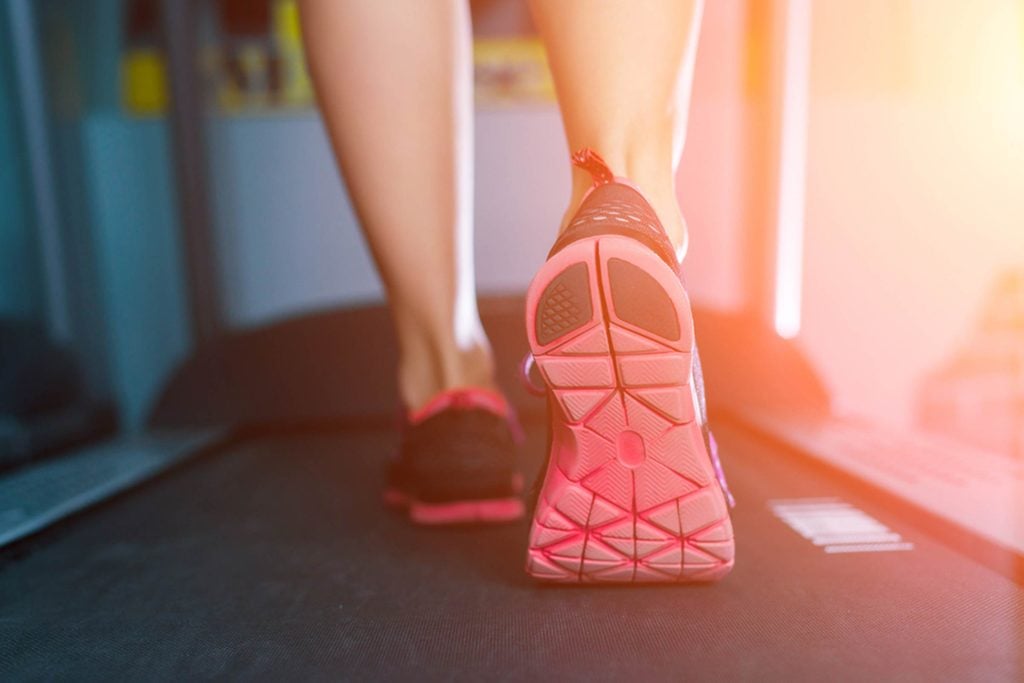Walking Could Burn More Fat Than Running—but Don’t Get Too Excited
Updated: Aug. 09, 2017
The "fat-burn" setting on your treadmill doesn't tell the whole story.
 If you’ve ever hopped on a treadmill and selected the “fat-burn” setting, you might realize something weird: The option aimed at weight loss is actually easier than the other settings. Instead of an intense cardio session, it uses a more relaxed pace. Seem too good to be true? Unfortunately, it is.
If you’ve ever hopped on a treadmill and selected the “fat-burn” setting, you might realize something weird: The option aimed at weight loss is actually easier than the other settings. Instead of an intense cardio session, it uses a more relaxed pace. Seem too good to be true? Unfortunately, it is.
Your body gets its energy from calories, which come in the form of fat and carbohydrates. Typically, your body is burning a combination of both. Weirdly enough, the harder you work out, the more of those calories will be coming from carbs instead of calories. For instance, one study in the Journal of Strength and Conditioning Research found that you’ll burn the most fat over carbs working at about 50 percent of your max heart rate. That level is a moderate pace that’s easy to hold a conversation at—far from the all-out sprint you’d normally associate with the biggest burn.
Sounds backwards that a more intense sweat session would actually blast less fat, but to your body it makes perfect sense. “Carbs are more easily converted to energy,” says certified personal trainer and fitness nutrition specialist Dani Singer, fitness director of Fit2Go Personal Training. “Fat you have to break down and use different components.” Shredding through carbs instead of wasting energy converting fat makes it easier to push through that tough workout. (So should you carboload? Science just figured out if you should eat before a workout or not.)
Because light cardio actually digs more into your fat stores to burn calories, it might seem like you’d be better off going for a long walk than working up a sweat running. But don’t get too excited—you don’t actually have an excuse to give up cardio.
Burning fat during a workout doesn’t necessarily mean you’re melting fat from your belly. “Fat loss is not based on percent of fat vs. carbs,” says Singer. “It’s based on calories.” So the workouts that burn the most calories will actually be better for weight loss. After all, you’re burning the highest percentage of calories from fat when you’re at rest, he says. If optimizing fat burn was the most important thing, we could all lie on the couch and expect results.
Just because you’re burning carbs instead of fat during your workout doesn’t mean that fat is destined to stick around. In fact, just the opposite is true. Forcing your body to work through its carb stores during an intense workout means it needs to dip into those fat stores later, so you’ll actually burn more fat in the long run.
And that calorie burning will be more effective, too. After an intense workout, your body needs to recover from the oxygen it lost, which is why you don’t stop panting as soon as you step foot off the treadmill. That recovery process lasts for hours, so your metabolism stays kicked into gear even hours after your breath is back to normal. With a higher metabolism, you can burn through those fat calories quicker than ever. Studies have even pegged exactly how many minutes you need to work out to burn fat all day.
The thing is, you wouldn’t get that boost from a leisurely stroll. “If you walk at a snails pace for an hour, your body can keep up with it,” says Singer. When your body doesn’t need to recover, it doesn’t need to pump up its metabolism either. Though you can still try these tricks for speeding up your metabolism.
Plus, regardless of the fat-to-carb ratio of calories you’re burning, you’ll probably blast more fat during an intense workout anyway, says Singer. “It doesn’t matter if the ratio is different—the total amount of fat calories is more than it would be at a steady pace,” says Singer. A tough workout requires so many more calories than an easy one that even though a lower percentage comes from fat, you’ll actually burn more fat calories on the whole.
For an effective weight-loss program, try high intensity interval training (HIIT), suggests Singer. You’ll give some form of cardio—whether running, dancing, or jumping rope—your all for 30 seconds, then recover for a minute and a half. Putting your body through that recovery period actually helps you blast more calories. (Learn more about the benefits of HIIT.)
But the single best program you can do? Whatever you love most. If you look forward to your daily walk but dread the sprint circuit you’ve tried committing too, you’ll fall off the wagon fast. “Find what you enjoy, and that’s what you’ll stick with,” says Singer. Borrow more tips from women who work out every day.